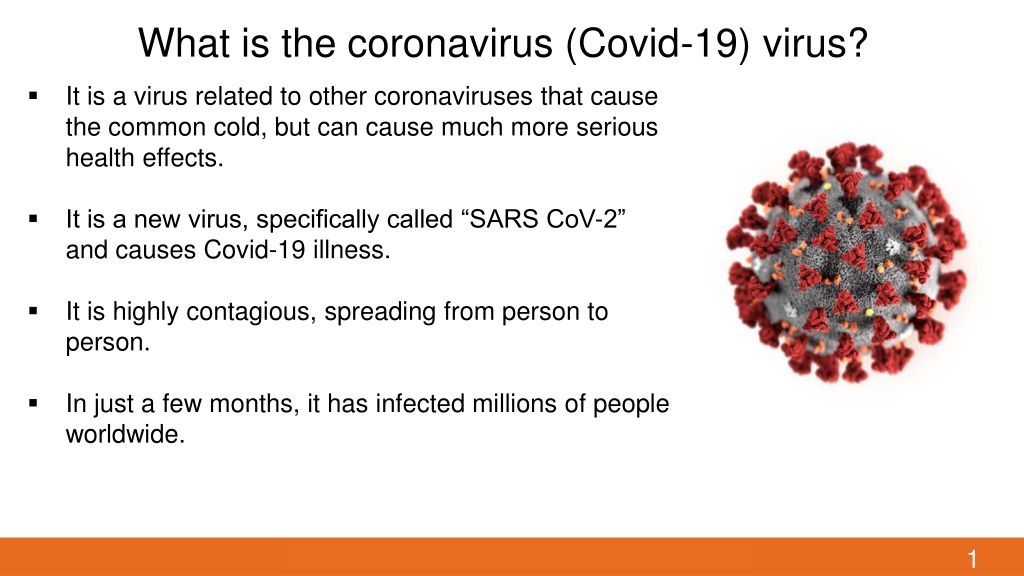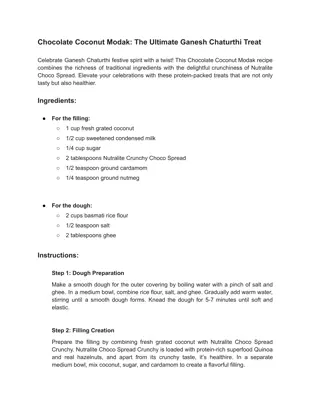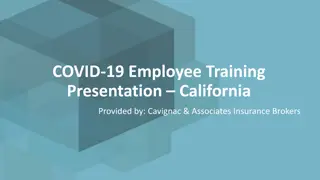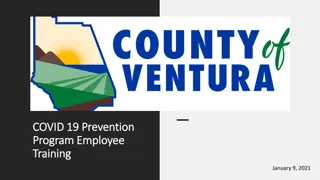Understanding Covid-19: Symptoms, Spread, and Risks at Work
The Covid-19 virus, SARS-CoV-2, has caused a global pandemic with symptoms such as fever, cough, and shortness of breath. It spreads through respiratory droplets and can be transmitted by asymptomatic carriers. If feeling sick, stay home and contact a healthcare provider. High-risk workers include healthcare professionals, while medium-risk occupations involve frequent close contact with others.
Download Presentation

Please find below an Image/Link to download the presentation.
The content on the website is provided AS IS for your information and personal use only. It may not be sold, licensed, or shared on other websites without obtaining consent from the author. Download presentation by click this link. If you encounter any issues during the download, it is possible that the publisher has removed the file from their server.
E N D
Presentation Transcript
What is the coronavirus (Covid-19) virus? It is a virus related to other coronaviruses that cause the common cold, but can cause much more serious health effects. It is a new virus, specifically called SARS CoV-2 and causes Covid-19 illness. It is highly contagious, spreading from person to person. In just a few months, it has infected millions of people worldwide. 1 Washington State Department of Labor & Industries
What are the symptoms of Covid -19 infection? COVID-19 typically causes mild respiratory illness, but can cause severe disease, including pneumonia-like illness. Typical symptoms include fever, cough, and shortness of breath. Other symptoms are chills, muscle aches, sore throat, loss of sense of taste or smell, nausea or vomiting and diarrhea. Symptoms begin 2-14 days after exposure. Some people have no symptoms. 2 Washington State Department of Labor & Industries
How is Covid-19 spread? It is spread from person to person mainly through respiratory droplets and aerosols from someone who is infected. It can spread to others from coughing, sneezing, singing and even talking. It also can spread from contact with contaminated surfaces or objects. Infected people without symptoms can spread the virus. 3 Washington State Department of Labor & Industries
What to do if you feel sick If you believe you may have the coronavirus, stay home and call your healthcare provider. If you have been infected, you likely had no symptoms for several days, and you may have passed the infection onto co-workers. Inform your employer, so they can determine who you may have been in contact with at work. 4 Washington State Department of Labor & Industries
Who is at risk at work? Extremely High Risk: Healthcare workers treating or caring for coronavirus infected patients. EMT/ambulance employees transporting infected persons. High Risk: Courtesy of ABC Radio National - Australia Dental workers and others who perform procedures that aerosolize saliva or mucous from the mouth or nose. 5 Washington State Department of Labor & Industries
Who is at risk (continued) Medium Risk: Any job requiring you to work within 6 feet of others several times a day for several minutes either: Outdoors, OR Indoors, without sneeze guards or other physical barriers Examples: grocery store stockers, public transit drivers, kitchen workers, hair salons 6 Washington State Department of Labor & Industries
How to protect yourself and others Keep physical distance of at least 6 feet. Practice frequent hand washing for 20 seconds and/or use hand sanitizer if soap and water are not available. Frequently sanitize work surfaces and tools. Cover coughs and sneezes and wear a facemask. Avoid touching the eyes, nose, or mouth with unwashed hands or gloves. Stay home if you are sick and avoid co-workers who appear sick. 7 Washington State Department of Labor & Industries
Face Coverings, Masks, and Respirators All three help prevent risk for spreading the virus to others. The Center for Disease Control (CDC) estimates that 40% of infections come from people with no symptoms. Depending on your job, level of risk, and whether prevention measures like physical barriers are used, you may be required to wear a disposable mask or respirator instead of a cloth face covering. 8 Washington State Department of Labor & Industries
Face coverings, masks, and respiratorswhich should I wear? Low risk jobs: homemade cloth face coverings or purchased cloth face coverings. Medium risk jobs: Disposable surgical-style mask, dust masks or KN95 masks. High & extremely high risk jobs: NIOSH-approved N-95, P-100 or foreign approved KN-95 respirators. 9 Washington State Department of Labor & Industries
CDC Order effective 2/1/2021 https://www.cdc.gov/quarantine/masks/mask-travel-guidance.html Low risk jobs: homemade cloth face coverings or purchased cloth face coverings. The following are attributes of masks needed to fulfill the requirements of the Order. CDC will update this guidance as needed. A properly worn mask completely covers the nose and mouth. Cloth masks should be made with two or more layers of a breathable fabric that is tightly woven (i.e., fabrics that do not let light pass through when held up to a light source). Mask should be secured to the head with ties, ear loops, or elastic bands that go behind the head. If gaiters are worn, they should have two layers of fabric or be folded to make two layers. Mask should fit snugly but comfortably against the side of the face. Mask should be a solid piece of material without slits, exhalation valves, or punctures. 10 Washington State Department of Labor & Industries
Fully vaccinated workers Fully vaccinated means vaccination by FDA-authorized vaccines (such as Moderna, Pfizer or Johnson & Johnson) and the appropriate wait time after vaccination has passed (usually 2 weeks). You must be able provide verification of vaccination, like a CDC vaccination card or other proof. Caregivers MUST wear Masks when caring for their Clients 11 Washington State Department of Labor & Industries
Wear a Mask & Wash your Hands 12 Washington State Department of Labor & Industries























